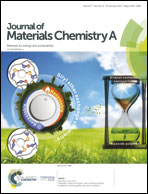Insights into the interfacial carrier behaviour of copper ferrite (CuFe2O4) photoanodes for solar water oxidation†
Abstract
Designing efficient yet robust photoanodes for water oxidation stands out as a major bottleneck in the realization of a feasible photoelectrochemical tandem cell for solar water splitting. Spinel copper ferrite (CuFe2O4) has been recently reported as a potential candidate photoanode, exhibiting an extended light absorption (band gap of 1.9 eV) with respect to traditional metal oxides. However, limiting factors dictating the poor performance (0.5 mA cm−2 at 1.6 V vs. RHE) remain unclear. Here, CuFe2O4 thin-film photoanodes were examined using frequency-dependent electrochemical techniques, namely photoelectrochemical impedance spectroscopy (PEIS) and intensity-modulated photocurrent/photovoltage spectroscopy (IMPS/IMVS), to provide a detailed description of the photogenerated charge carrier behaviour under operational conditions. Results evidenced a strong Fermi level pinning during oxygen evolution caused by the accumulation of surface intermediates and a relatively slow rate of charge transfer (ktran ∼ 5 s−1). Moreover, the short hole diffusion length (Lp ∼ 4 nm) and the low charge collection efficiency (below 10%) further prevent efficient charge extraction. Overall, these findings point towards the need of both film nanostructuring and surface engineering to further advance this photoanode.



 Please wait while we load your content...
Please wait while we load your content...